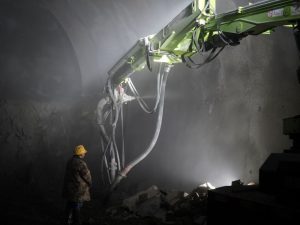Why do you have to spray concrete? Spraying concrete, also known as shotcreting or sometimes colloquially referred to as "gunite" (a specific type of dry-mix shotcrete), is a construction technique used for applying concrete in various applications. This method involves spraying the concrete at high velocity onto surfaces using a hose and nozzle, allowing it to adhere and set quickly. The process has several advantages over traditional pouring methods, making it particularly useful in certain situations.

Advantages of Spraying Concrete:
1. Increased Strength and Durability: When sprayed correctly, concrete achieves greater density due to the high-velocity impact of the particles against the surface being coated. This results in fewer voids within the concrete structure, leading to higher strength and improved durability compared to conventionally placed concrete.
2. Versatility in Placement: Shotcrete can be applied vertically, overhead, or even on complex geometries where normal pouring would not be feasible. It’s especially advantageous for building underground structures like tunnels, retaining walls, and shafts, as well as for repairing deteriorated structures without needing formwork.
3. Quicker Setting Time: The high-pressure application allows for quicker setting times than traditionally poured concrete, which means less waiting time between layers and faster completion of projects. This can significantly reduce overall project duration and costs associated with labor and equipment rentals.
4. Better Surface Finish: The forceful impact of the wet mix on the substrate can result in a smoother finish that requires less finishing work after placement. For architectural finishes, this can lead to significant cost savings.
5. Reduction in Waste: With precise control over where the concrete is placed, there's less waste involved since the material is directly targeted only where needed. This efficiency reduces both material usage and environmental impact by minimizing excess and runoff.
6. Easier Access to Difficult Areas: In tight spaces or areas with difficult access, spraying concrete provides an advantage over other methods because it doesn’t require large machinery to place the material accurately. This makes it ideal for remote locations or confined environments.
7. Improved Safety: By reducing the need for workers to handle heavy concrete loads manually, spraying techniques lower the risk of injuries related to lifting and moving heavy materials. Additionally, when used properly, it minimizes dust exposure for workers compared to conventional mixing processes.
8. Reduced Downtime: Quick setup and rapid curing allow for shorter downtime periods in industrial settings such as mines or tunnels, ensuring minimal disruption to operations.
9. Customizable Mixes: Depending on the application, different aggregates, additives, and admixtures can be added to alter the properties of the concrete for specific needs—such as increased resistance to water penetration, fire protection, or chemical resistance.
Spraying concrete offers numerous benefits over traditional pouring methods, making it a preferred choice in many construction scenarios where speed, flexibility, strength, and ease of application are critical factors. Its widespread use across industries from infrastructure development to repair works demonstrates its effectiveness and adaptability. Whether enhancing structural integrity or speeding up construction timelines, shotcrete continues to play a crucial role in modern building practices around the world.




